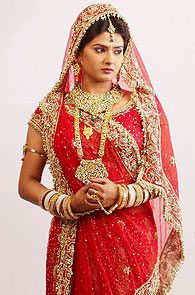 State-of-the-art makeup?
State-of-the-art makeup?
Check.
Resurrection of the dead?
Check.
Alternate universe location setting?
Check.
Welcome to the world of Indian sci-fi shows, available for viewing from 7 pm until 12 midnight on all major Hindi channels throughout the week.
If you’re low on the pecking order in the family, if you have neither control over the remote nor an alternate venue to receive free food from at dinner time, it is highly probably that you have already had your first encounter with daily soaps. However, if you haven’t watched them yet and are a sci-fi fan, much like myself, then you’re really missing out.
Scattered across a myriad of channels, these soaps are highly popular with audiences from working-class women to upper-middle class housewives. It is an open secret that more than a handful of husbands and grandfathers have been sucked into this parallel universe of the K-serial. A simple click of a button, a mere glance at the screen can transport you to the world of The Nefarious K.
The Nefarious K is an evil, invisible entity that provides a common thread to all the K-serials on various channels -- aside from the stereotypical characters, repetitive story lines and glorification of abuse, of course.
The Nefarious K, after whom (I suspect) the K-serials are named, acts as an ever-present antagonist. Quite like Agent Smith from The Matrix Trilogy, The Nefarious K is within the system. It worms its way into characters as well, possessing them and making them do things that no rational human being ever would. Eventually The Nefarious K replicates itself within the possessed character and the process is complete. The seeds of malevolence (read: dim-wittedness) have been sown.
Now, the pillars of self-righteousness that hold up the K Universe in perfect harmony begin to crumble: the good, obedient daughter actually develops a personality and demonstrates this by performing the rebellious act of wearing jeans; the good, submissive bahu ditches her ghunghat as well as her husband to focus on something as scandalous as a career, leaving the rest of the family (who may only move as a herd between the realms of the living room and the dining room, for reasons unknown) to gasp in horror. This clearly demonstrates how easily The Nefarious K can manipulate people’s personalities. All it has to do is get them to wear those immoral Western clothes.
However, it is interesting to observe that immoral Western clothes wearing men are not transformed at all. Perhaps the men-folk inside the K Universe have developed some sort of firewall against The Nefarious K which stops it from infecting their systems.
In each story the subservient bahu sacrifices any autonomy over her life, silently bears abuse, smilingly accepts her place as nothing but a housemaid and finally finds her happy ending when she is the matriarch of the family by defeating The Nefarious K and all those who had been infected by it. But The Nefarious K is not nearly gone.
Although The Nefarious K may have been kicked out of happily ended individual stories by these characters, it still looms as a collective threat over the K Universe. From time immemorial, when once the mother-in-law was also a daughter-in-law (hint, hint), The Nefarious K has terrorized the K Universe. No one knows when, or if, the K Universe will finally receive it’s One. All we can do is stay in our chairs and keep watching.
But why do we keep watching? Why are we so addicted to the K-serials? Is it our love for the Haldiram’s wrapper-like saris or the brilliantly done makeup that lends even the most human-looking
The K Universe offers us a world where characters we can relate to live the lives that we want to live. They are people who carry our value system but are placed in an environment of excess. They react to situations in ways similar to ours and yet live in the palaces we could only dream of having, come to breakfast wearing enough gold to make any of us topple under its weight and have servants to do the menial chores that we believe degrade us when we perform them ourselves. The K Universe is a safe refuge that reinforces all the wrongs in our culture and puts them up on a pedestal as a set of values that we must all follow, thus taking away our guilt about our compliance in following them. When we are no longer complicit, we are no longer guilty.
The Nefarious K, the mortal enemy of the inhabitants of the K Universe, might actually not be such an evil force after all, despite the ethical dilemmas that it pushes the characters of the K-serials into. For a few seconds it upsets their moral high-ground, thereby upsetting our moral high-ground, and thrusts us all out of the K Universe, into the real world and its harsh truths (domestic violence, female foeticide, dowry murders, to name a few) that cannot be solved by oversimplified solutions such as “educate the people”.
Perhaps the presence of The Nefarious K is the only thing that prevents these sci-fi soap operas from turning into full-blown fantasy/drama Asaram Bapu-like sermons on maryada and morality.
It is interesting to observe the journey of The Nefarious K. While it may, to some, represent the doom that is always lurking on the horizon for the inhabitants of the K-Universe, to others it may represent the remnants of the human conscious that resists inflicting harm upon others as well as having harm inflicted upon its person for the most illogical of reasons. How much of this conscious remains within ourselves is yet to be seen but will most likely be inversely proportional to the number of seasons that the K-serials run for.
The K-Universe plays out the inner most desires of our collective social conscious while suppressing our individual conscious. The Nefarious K on the other hand, tries to infect this pseudo-utopia of ‘Indian culture’ with fervent doses of reality. The success of The Nefarious K may be the only solution to bringing back those stuck in the simulated world of the K Universe. But how many of us really want to come back? How many of us would rather choose the red pill of truth over the blue one of blissful ignorance?
The beauty of The Nefarious K is that it is within each of us. We have all been infected. It is this infection that acts as a vaccine against the simulated reality of the K Universe.
Yet, the question remains: what really is The Nefarious K? Is it a force? Is it a supreme being, perhaps? Or is it just that voice in the back of our minds that urges us to ask “why”? Perhaps the Nefarious K is just a reflection of the facts we are aware of but hide from even ourselves. Perhaps the Nefarious K isn’t so nefarious after all.
But it’s just TV, right? How does the fact that it has 600 million viewers even matter? There’s always the option of changing the channel; but change to what? Maybe a nine o’clock news anchor screaming his lungs out at all those who dare contradict him would act as an appropriate substitute to the drama of the K-serials.
Either way, I’ve decided to start eating dinner in my room. Self-righteous propaganda and food are too much to swallow at once.









